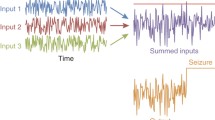Abstract
The term “seizure” underscores two fundamental characteristics of epileptic phenomena: they are sudden and unexpected deviations from the normal function of the nervous system. Thus 2 important criteria for a candidate convulsant mechanism are that the mechanism is compatible with normal neural functioning, and that the mechanism can produce rapid deviations from normal function. For example, the blockade of GABA-mediated inhibition is a robust and frequently studied experimental convulsant mechanism,26,28 but is unlikely to underlie human epilepsy because it is not compatible with normal function nor is it capable of sudden transitions from normal function. Of course, we can modify the GABA-block hypothesis to incorporate the “sudden and unexpected” criterion by proposing that the sudden and unexpected features arise from the condition that imposes the reduction in GABA efficacy.
Access this chapter
Tax calculation will be finalised at checkout
Purchases are for personal use only
Preview
Unable to display preview. Download preview PDF.
Similar content being viewed by others
References
Alger BE, Nicoll RA. Pharmacological evidence for two kinds of GABA receptor on rat hippocampal pyramidal cells studied in vitro. J Physiol 1982; 328: 125–141.
Alger BE, Nicoll RA. Feed-forward dendritic inhibition in rat hippocampal pyramidal cells studied in vitro. J Physiol 1982; 328: 105–123.
Andersen P, Dingledine R, Gjerstad L. Two different responses of hippocampal pyramidal cells to application of gamma-amino butyric acid. J Physiol 1980; 305: 279–296.
Archer DP, Samanani N, Roth SH. Small-dose pentobarbital enhances synaptic transmission in rat hippocampus. Anesth Analg 2001; 93: 1521–1525
Ballanyi K, Grafe P. An intracellular analysis of gamma-aminobutyric-acid-associated ion movements in rat sympathetic neurones. J Physiol 1985; 365: 41–58.
Barker JL, Ransom BR. Amino acid pharmacology of mammalian central neurones grown in tissue culture. J Physiol 1978; 280: 331–54.
Bormann J, Hamill OP, Sakmann B. Mechanism of anion permeation through channels gated by glycine and gamma-aminobutyric acid in mouse cultured spinal neurones. J Physiol 1987; 385: 243–286.
Dallwig R, Deitmer JW, Backus KH. On the mechanism of GABA-induced currents in cultured rat cortical neurons. Pflugers Arch 1999; 437: 289–97.
Grover LM, Lambert NA, Schwartzkroin PA et al. Role of HCO3 ions in depolarizing GABAA receptor-mediated responses in pyramidal cells of rat hippocampus. J Neurophysiol 1993; 69: 1541–1555.
Huguenard JR, Alger BE. Whole-cell voltage-clamp study of the fading of GABA-activated currents in acutely dissociated hippocampal neurons. J Neurophysiol 1986; 56: 1–18.
Jarolimek W, Lewen A, Misgeld U. A furosemide-sensitive K’-Cl“ cotransporter counteracts intracellular CI- accumulation and depletion in cultured rat midbrain neurons. J Neurosci 1999; 19: 4695–4704.
Kaila K, Voipio J. Postsynaptic fall in intracellular pH induced by GABA-activated bicarbonate conductance. Nature 1987; 330: 163–165.
Kaila K. Ionic basis of GABAA receptor channel function in the nervous system. Prog Neurobiol 1994; 42: 489–537.
Kaila K, Lamsa K, Smirnov S. Long-lasting GABA-mediated depolarization evoked by high-frequency stimulation in pyramidal neurons of rat hippocampal slice is attribuatable to a network-driven, bicarbonate-dependent K’ transient. J Neurosci 1997; 17: 7662–7672.
Meldrum B. Update on the mechanism of action of antiepileptic drugs. Epilepsia 1996; 37 Suppl 6: S4–11.
Payne JA. Functional characterization of the neuronal-specific K-Cl cotransporter: implications for [K’]o regulation. Am J Physiol 1997; 273 (5 Pt 1): C1516–1525.
Perkins KL, Wong RKS. Ionic basis of the postsynaptic depolarizing GABA response in hippocampal pyramidal cells. J Neurophysiol 1996; 76: 3886–3894.
Perreault P, Avoli M. A GABAergic depolarizing potential in the hippocampus disclosed by the convulsant 4-aminopyridine. Brain Res 1987; 400: 191–195.
Perreault P, Avoli M. A depolarizing inhibitory postsynaptic potential activated by synaptically released gamma-aminobutyric acid under physiological conditions in rat hippocampal pyramidal cells. Can J Physiol Pharmacol 1988; 66: 1100–1102.
Sato J, Nioka M, Owada E. Effect of acetazolamide on the anticonvulsant potency of phenobarbital in mice. J Pharmacobiodyn 1981; 4: 952–960.
Scharfman HE, Sarvey JM. Responses to gamma-aminobutyric acid applied to cell bodies and dendrites of rat visual cortical neurons. Brain Res 1985; 358: 385–389.
Scharfman HE, Sarvey JM. Responses to GABA recorded from identified rat visual cortical neurons. Neuroscience 1987; 23: 407–422.
Staley KJ, Soldo BL, Proctor WR. Ionic mechanisms of neuronal excitation by inhibitory GABAA receptors. Science 1995; 269: 977–981.
Staley KJ, Proctor WR. Modulation of mammalian dendritic GABA(A) receptor function by the kinetics of C1 and HCO3 transport. J Physiol 1999; 519 Pt 3: 693–712.
Thalmann RH. Blockade of a late inhibitory postsynaptic potential in hippocampal CA3 neurons in vitro reveals a late depolarizing potential that is augmented by pentobarbital. Neurosci Lett 1988; 95: 155–60.
Thompson SM, Deisz RA, Prince DA. Relative contributions of passive equilibrium and active transport to the distribution of chloride in mammalian cortical neurons. J Neurophysiol 1988; 60: 105–124.
Thompson SM, Gähwhiler BH. Activity-dependent disinhibition. I. repetitive stimulation reduces IPSP driving force and conductance in the hippocampus in vitro. J Neurophysiol 1989a; 61: 501–511.
Treiman DM. GABAergic mechanisms in epilepsy. Epilepsia 2001; 42 (Suppl 3): 8–12.
Staley K, Smith R. A new form of feedback at the GABA(A) receptor. Nat Neurosci 2001; 4: 674–676.
Editor information
Editors and Affiliations
Rights and permissions
Copyright information
© 2004 Springer Science+Business Media New York
About this chapter
Cite this chapter
Staley, K.J. (2004). Role of the Depolarizing GABA Response in Epilepsy. In: Binder, D.K., Scharfman, H.E. (eds) Recent Advances in Epilepsy Research. Advances in Experimental Medicine and Biology, vol 548. Springer, Boston, MA. https://doi.org/10.1007/978-1-4757-6376-8_8
Download citation
DOI: https://doi.org/10.1007/978-1-4757-6376-8_8
Publisher Name: Springer, Boston, MA
Print ISBN: 978-1-4419-3418-5
Online ISBN: 978-1-4757-6376-8
eBook Packages: Springer Book Archive




